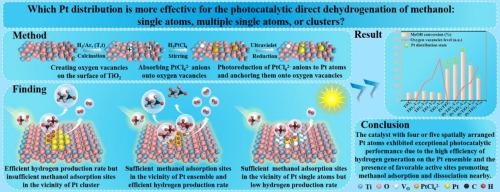当前位置:
X-MOL 学术
›
Chem. Eng. J.
›
论文详情
Our official English website, www.x-mol.net, welcomes your
feedback! (Note: you will need to create a separate account there.)
Pt single-atom-layer ensembles on TiO2 for direct dehydrogenation of methanol to hydrogen and methyl formate
Chemical Engineering Journal ( IF 13.3 ) Pub Date : 2024-11-20 , DOI: 10.1016/j.cej.2024.157836 Min Zhao, Guanjun Gao, Haoran Du, Xiran Xiao, Xuzhuang Yang
Chemical Engineering Journal ( IF 13.3 ) Pub Date : 2024-11-20 , DOI: 10.1016/j.cej.2024.157836 Min Zhao, Guanjun Gao, Haoran Du, Xiran Xiao, Xuzhuang Yang

|
Controlling the distribution state of active components to regulate the photocatalytic performance of green hydrogen production from methanol, while achieving zero carbon emissions, poses a significant challenge. In this study, we synthesized photocatalysts with varying distribution states of Pt single atoms on TiO2 by modulating the surface oxygen vacancies. The photocatalytic performance of these catalysts in the direct dehydrogenation of methanol to hydrogen and methyl formate was assessed at room temperature. Our findings revealed that the number of surface oxygen vacancies on TiO2 influenced the distribution states of Pt, including single Pt atoms, Pt dimers, Pt trimers, Pt ensembles with approximately five atoms, and Pt ensembles with more than ten single-layer atoms. These Pt species were anchored to surface oxygen vacancies on TiO2 in the form of Pt2+. The distribution states of Pt and the remaining oxygen vacancies significantly impact light absorption and electron transfer properties, ultimately influencing the catalytic performance of the photocatalysts. Notably, the Pt/TiO2-VO2 catalyst, characterized by a spatial arrangement of five Pt atoms, demonstrated exceptional photocatalytic performance in the reaction, primarily attributable to the presence of favorable active sites facilitating methanol adsorption and dissociation in the vicinity of the Pt ensemble, along with the notably high efficiency of hydrogen generation on the Pt ensemble. The vacancies served as active sites for the adsorption and dissociation of methanol molecules, while the Pt single-atom-layer ensembles were identified as effective active sites for H2 generation. This study provides valuable insights for the design and preparation of efficient photocatalysts for the direct dehydrogenation of methanol to hydrogen and methyl formate through photocatalysis.
中文翻译:

TiO2 上的 Pt 单原子层系结,用于将甲醇直接脱氢成氢气和甲酸甲酯
控制活性组分的分布状态以调节甲醇制绿色氢的光催化性能,同时实现零碳排放,是一项重大挑战。在这项研究中,我们通过调节表面氧空位合成了 Tt 单原子在 TiO2 上具有不同分布态的光催化剂。在室温下评估了这些催化剂在甲醇直接脱氢制氢和甲酸甲酯中的光催化性能。我们的研究结果表明,TiO2 上表面氧空位的数量影响了 Pt 的分布状态,包括单个 Pt 原子、Pt 二聚体、Pt 三聚体、大约五个原子的 Pt 集成和具有 10 个以上单层原子的 Pt 集成。这些 Pt 物质以 Pt2+ 的形式锚定在 TiO2 上的表面氧空位上。Pt 的分布态和剩余的氧空位显着影响光吸收和电子转移性能,最终影响光催化剂的催化性能。值得注意的是,Pt/TiO2-V O2 催化剂的特征是 5 个 Pt 原子的空间排列,在反应中表现出优异的光催化性能,这主要是由于存在有利于甲醇吸附和解离的活性位点在 Pt 系集成附近,以及 Pt 系聚上显着的高产氢效率。空位是甲醇分子吸附和解离的活性位点,而 Pt 单原子层集合被确定为 H2 生成的有效活性位点。 本研究为设计和制备高效的光催化剂提供了有价值的见解,用于通过光催化将甲醇直接脱氢为氢和甲酸甲酯。
更新日期:2024-11-20
中文翻译:

TiO2 上的 Pt 单原子层系结,用于将甲醇直接脱氢成氢气和甲酸甲酯
控制活性组分的分布状态以调节甲醇制绿色氢的光催化性能,同时实现零碳排放,是一项重大挑战。在这项研究中,我们通过调节表面氧空位合成了 Tt 单原子在 TiO2 上具有不同分布态的光催化剂。在室温下评估了这些催化剂在甲醇直接脱氢制氢和甲酸甲酯中的光催化性能。我们的研究结果表明,TiO2 上表面氧空位的数量影响了 Pt 的分布状态,包括单个 Pt 原子、Pt 二聚体、Pt 三聚体、大约五个原子的 Pt 集成和具有 10 个以上单层原子的 Pt 集成。这些 Pt 物质以 Pt2+ 的形式锚定在 TiO2 上的表面氧空位上。Pt 的分布态和剩余的氧空位显着影响光吸收和电子转移性能,最终影响光催化剂的催化性能。值得注意的是,Pt/TiO2-V O2 催化剂的特征是 5 个 Pt 原子的空间排列,在反应中表现出优异的光催化性能,这主要是由于存在有利于甲醇吸附和解离的活性位点在 Pt 系集成附近,以及 Pt 系聚上显着的高产氢效率。空位是甲醇分子吸附和解离的活性位点,而 Pt 单原子层集合被确定为 H2 生成的有效活性位点。 本研究为设计和制备高效的光催化剂提供了有价值的见解,用于通过光催化将甲醇直接脱氢为氢和甲酸甲酯。


















































 京公网安备 11010802027423号
京公网安备 11010802027423号